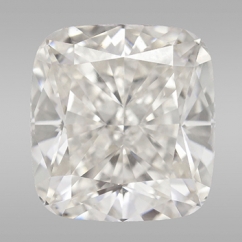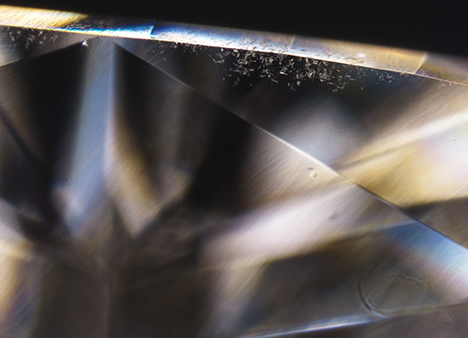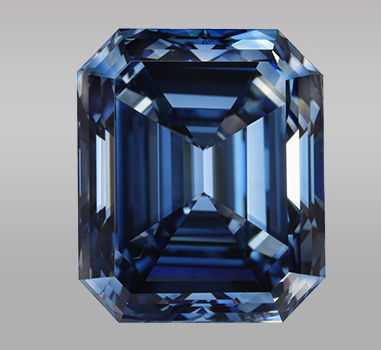Articles and News
GIA Warns New Five-Carat CVD Synthetic Diamond Looks Natural Under Microscope | October 19, 2016 (0 comments)

Carlsbad, CA—A CVD-method synthetic diamond weighing more than five carats was recently tested by Gemological Institute of America (GIA)’s laboratory in Hong Kong. GIA says this is both the largest CVD synthetic diamond it has examined to date, and the largest faceted CVD synthetic gem diamond reported in the jewelry industry.
Image at left: This 5.19 ct CVD synthetic diamond (10.04 × 9.44 × 6.18 mm, with J-equivalent color and VS2-equivalent clarity) is the largest GIA has identified to date. Photo by Johnny Leung and Tony Leung, courtesy GIA.
The stone’s size indicates a significant milestone in the CVD (chemical vapor deposition) method of growing diamonds in a laboratory (HPHT is the other method used.), but more importantly—and more worrisome to the industry—it exhibited enough characteristics to be mistaken for a natural diamond without advanced testing by spectroscope, says GIA.
GIA has published two research articles discussing developments in the man-made diamond industry: “CVD Synthetic Diamond Over 5 Carats Identified in GIA Laboratory” and “HPHT Synthetic Blue Diamond Over 10 carats.” Some findings and observations summarized in the CVD article include:
- The synthetic diamond, a cushion modified brilliant, was identified as synthetic after being submitted to GIA for grading without disclosure.
- Infrared absorption spectroscopy identified the sample is type IIa.
- The stone was observed to have color comparable to a “J” color and clarity comparable to VS2. GIA Synthetic Diamond Grading Reports use ranges rather than specific grades to describe the color and clarity of synthetic diamonds.
- If examined only under a microscope, this synthetic could be mistakenly identified as natural.
- Natural looking internal inclusions such as needles, clouds and fractures in the table were observed.
- Black inclusions, often contained in synthetic diamond, were not found in this specimen.
While luxury jewelers typically require grading reports for all large stones they buy and provide them with the sale to the consumer--hence the chance of a synthetic this size being sold deceptively as natural is small--GIA says this finding highlights the importance of using advanced spectroscopic instruments in addition to conventional gemological techniques to assure proper identification.

Needles and pinpoints were the major internal features. Black inclusions, a common feature of CVD synthetic diamond, were not observed. Photo by Billie “Pui Lai” Law, courtesy GIA.
In September, the Institute also examined a 10.08-carat synthetic blue diamond produced using the high pressure/high temperature (HPHT) method. It was the largest HPHT synthetic diamond GIA has examined. Some findings and observations summarized in GIA's HPHT blue diamond article include:
- The emerald cut synthetic diamond has a color equivalent to Fancy Deep Blue.
- Very small metallic inclusions and fractures were observed under magnification.
- Infrared absorption spectroscopy confirmed the sample is type IIb.
- The diamond showed clear red-orange fluorescence to long-wave UV and yellow fluorescence to short-wave UV radiations.

This 10.08 ct (13.54 × 11.39 × 7.36 mm) HPHT-grown diamond, with color equivalent to Fancy Deep blue, was the largest HPHT synthetic to date. Photo by Johnny Leung, courtesy GIA.
With continued advancements in synthetic diamond production, GIA launched a pilot for its Melee Analysis Service in mid-2016 in order to address industry concerns about the possibility of synthetic or treated diamonds being mixed into parcels of melee. This is the area that the rapid development of high quality gem synthetic diamonds puts luxury jewelers--indeed, all jewelers--most at risk for unwittingly passing along a synthetic as natural.
In August, a parcel of melee (3,005 stones, 70.56 ctw) was submitted to GIA’s New York lab for the service. Initial testing using the fully automatic screening device passed 2,969 (98.7%) of the stones as natural diamond. Of the remaining 36 stones,12 were identified as natural by methods including photoluminescence spectroscopy, and 24 were referred for further testing to confirm their identity as natural, treated, or synthetic diamond. Of these, three were HPHT-grown synthetic diamonds. You can read the full report here.
For a complete bibliography of synthetic diamond articles featured in Gems & Gemology, visit http://www.gia.edu/synthetic-diamond-articles.
Separately, on October 7 GIA celebrated the 25th anniversary of its Career Fair at its Carlsbad, CA headquarters. The event drew more than 800 gem and jewelry enthusiasts for a day full of panel discussions, one-on-one career coaching, education demonstrations and networking. Job seekers also had a chance to meet with 32 companies looking to fill hundreds of positions at experience levels across the value chain. The success of GIA’s Jewelry Career Fair is due to the generous mentorship of career coaches, expertise of panelists and participation of recruiters, says the Institute. The next Career Fair will take place in New York on Monday, July 24, 2017. For more details, visit gia.edu/career-fair or email careerfair@gia.edu. Follow @GIANews #JewelryJobs for updates.







